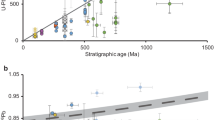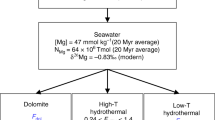Abstract
We investigate the potential role of dolomite as a long-term buffer on Phanerozoic seawater composition. Using a comprehensive model of Phanerozoic geochemical cycling, we show how variations in the formation rate of sedimentary marine dolomite have buffered seawater saturation state. The total inventory of inorganic carbon reflects the sum of fluxes derived from continental weathering, basalt-seawater exchange, alumino-silicate diagenesis (reverse weathering), and global deposition of calcium carbonate. Although these fluxes are approximately balanced, model results indicate that seawater saturation state is sensitive to the marine dolomite depositional flux. This conclusion is consistent with and constrained by independent proxy data for seawater ion ratios, paleo-atmospheric CO2 concentrations, and paleo-pH data, and dolomite mass-age distribution through Phanerozoic time. Abundant research indicates that dolomite’s occurrence in marine sediments is sensitive to many factors: temperature, seawater composition, paleogeographic setting, continental organization, etc. Although the complexity of the process of dolomite formation prevents a complete understanding of the relative role of these factors, our model results clearly underscore the importance of this mineral in the chemical history of Phanerozoic seawater.





Similar content being viewed by others
References
Alt JC, Teagle DAH (1999) Uptake of carbon during alteration of oceanic crust. Geochim Cosmochim Acta 63:1527–1535
Arvidson RS, Mackenzie FT, Guidry M (2006) MAGic: a Phanerozoic model for the geochemical cycling of major rock-forming components. Am J Sci 306:135–190
Berner RA, Kothavala Z (2001) GEOCARB III: a revised model of atmospheric CO2 over Phanerozoic time. Am J Sci 301:182–204
Berner RA, Lasaga AC, Garrels RM (1983) The carbonate-silicate geochemical cycle and its effect on atmospheric carbon dioxide over the past 100 million years. Am J Sci 283:641−683
Boss SK, Wilkinson BH (1991) Planktogenic/eustatic control on cratonic/oceanic carbonate accumulation. J Geol 99:497–513
Compton JS (1980) Degree of supersaturation and precipitation of organogenic dolomite. Geology (Boulder) 16:318–321
Guidry MW, Arvidson RS, Mackenzie FT (2007) Biological and geochemical forcings to Phanerozoic change in seawater, atmosphere, and carbonate precipitate composition. In: Falkowski P, Knoll A (eds) Evolution of primary producers in the sea. Academic Press, San Diego, pp 377–403
Guidry MW (2007) A new approach to the solution of large thermonuclear networks. Proc Science, PoS (NIC-IX):107
Guidry MW Jr, Guidry MW Sr, Arvidson RS (2005) Application of stochastic methods to the modeling of nonlinear relationships between ocean productivity, ventilation, and atmospheric composition. Geol Soc Am Abstr Prog 37(7):333
Hardie LW (1996) Secular variation in seawater chemistry: an explanation for the coupled variation in the mineralogies of marine limestones and potash evaporites over the past 600 m.y. Geology (Boulder) 24:279–283
Holland H, Zimmermann H (2000) The dolomite problem revisited. Int Geol Rev 42:481–490
Horita J, Zimmermann H, Holland HD (2002) Chemical evolution of seawater during the Phanerozoic: implications from the record of marine evaporites. Geochim Cosmochim Acta 66:3733–3756
Lowenstein TK, Hardie LA, Timofeeff MN, Demicco RV (2003) Secular variation in seawater chemistry and the origin of calcium chloride basinal brines. Geology (Boulder) 31:857–860
Lowenstein TK, Timofeeff MN, Brennan ST, Hardie LA, Demicco RV (2001) Oscillations in Phanerozoic seawater chemistry: evidence from fluid inclusions. Science 294:1086–1088
Mackenzie FT, Morse JW (1992) Sedimentary carbonates through Phanerozoic time. Geochim Cosmochim Acta 56:3281–3295
Mackenzie FT, Pigott JD (1981) Tectonic controls of Phanerozoic sedimentary rock cycling. J Geol Soc 138(2):183–196
Mackenzie FT, Arvidson RS, Guidry M (2008) Chemostatic modes of the ocean-atmosphere-sediment system through Phanerozoic time. Mineral Mag 72(1):329–332
Mackenzie FT, Mucci A, Luther III GW (2010) In Memoriam: John W Morse (1946–2009) Texas A&M University. Aquat Geochem 16:219–221
Moore S, Murray RW, Kurtz AC, Schrag DP (2004) Anaerobic methane oxidation and the formation of dolomite. Earth Planet Sci Lett 229:141–154
Mottl MJ, Holland HD (1978) Chemical exchange during hydrothermal alteration of basalt by seawater. I. Experimental results for major and minor components of seawater. Geochim Cosmochim Acta 42:1103–1115
Pearson PN, Palmer MR (1999) Middle Eocene seawater pH and atmospheric carbon dioxide concentrations. Science 284:1825–1826
Pearson PN, Palmer MR (2000) Atmospheric carbon dioxide concentrations over the past 60 million years. Nature 406:695–699
Sandberg PA (1983) An oscillating trend in Phanerozoic non-skeletal carbonate mineralogy. Nature 305:19–22
Seyfried WE Jr, Mottl MJ, Bischoff JL (1978) Seawater/basalt ratio effects on the chemistry and mineralogy of spilites from the ocean floor. Nature 275:211–213
Spencer RJ, Hardie LA (1990) Control of seawater composition by mixing of river waters and mid-ocean ridge hydrothermal brines. In: Spencer RJ, Chou I-M (eds) Fluid-mineral interactions: a tribute to HP Eugster, Special publication no 2 geochemical society, San Antonio, pp 409−419
Stanley SM, Hardie LA (1998) Secular oscillations in the carbonate mineralogy of reef-building and sediment-producing organisms driven by tectonically forced shifts in seawater chemistry. Palaeogeogr Palaeoclimatol Palaeoecol 144:3–19
Volk T (1989) Sensitivity of climate and atmospheric CO2 to deep-ocean and shallow-ocean carbonate burial. Nature 337:637–640
Wilkinson BH, Algeo TJ (1989) Sedimentary carbonate record of carbonate—magnesium cycling. Am J Sci 289:1158–1194
Wright DT, Wacey D (2005) Precipitation of dolomite using sulphate-reducing bacteria from the Coorong Region, South Australia: significance and implications. Sedimentology 52:987–1008
Wilkinson BH, Walker JCG (1989) Phanerozoic cycling of sedimentary carbonate. Am J Sci 289:525–548
Zimmermann H (2000) Tertiary seawater chemistry—implications from primary fluid inclusions in marine halite. Am J Sci 300:723–767
Zimmermann H (2001) On the origins of fluids included in Phanerozoic marine halite—basic interpretation strategies. Geochim Cosmochim Acta 65:35–45
Zenger DH, Jan FGB-L, Carozzi AV (1994) Dolomieu and the first description of dolomite. In: Purser B, Tucker M, Zenger D (eds) Dolomites: a volume in honour of Dolomieu (IAS Spec. Pub. No. 21). Blackwell, Oxford, pp 21–28
Acknowledgments
The authors gratefully acknowledge the strong contributions of Mike Guidry and his students at the University of Tennessee, Knoxville in design and optimization of the model’s ODE solver algorithm. FTM and MWG acknowledge NSF Grant OCE 07-49401 for partial support of this research on long-term seawater pH and the CO2-carbonic acid system. We gratefully acknowledge the enormous influence John Morse (MacKenzie et al. 2010) has had on the research efforts of all three authors and his friendship over the years. We miss him dearly.
Author information
Authors and Affiliations
Corresponding author
Rights and permissions
About this article
Cite this article
Arvidson, R.S., Guidry, M.W. & Mackenzie, F.T. Dolomite Controls on Phanerozoic Seawater Chemistry. Aquat Geochem 17, 735–747 (2011). https://doi.org/10.1007/s10498-011-9130-7
Received:
Accepted:
Published:
Issue Date:
DOI: https://doi.org/10.1007/s10498-011-9130-7




